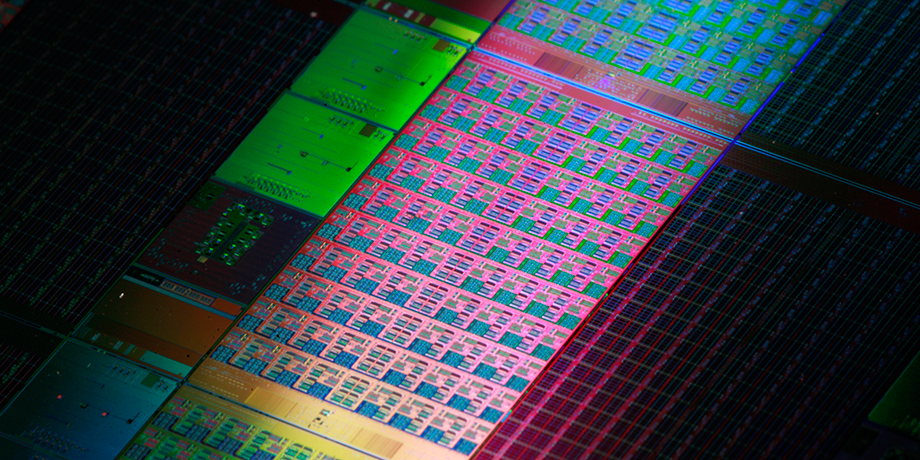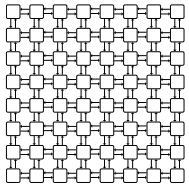CSC/ECE 506 Spring 2012/12b sb: Difference between revisions
| Line 35: | Line 35: | ||
=== 2-D Mesh === | === 2-D Mesh === | ||
This has been a very popular topology due to its simple design and low layout and router complexity. It is often described as a k-ary n-cube , where k is the number of nodes on each dimension, and n is the number of dimensions. For example, a 4-ary 2-cube is a 4x4 2D mesh. | [[File:Mesh.png|thumb|c|right|2D Mesh]]This has been a very popular topology due to its simple design and low layout and router complexity. It is often described as a k-ary n-cube , where k is the number of nodes on each dimension, and n is the number of dimensions. For example, a 4-ary 2-cube is a 4x4 2D mesh. | ||
One of the drawbacks of 2D Meshes is that the degree of the nodes along the edges is lower than the degree of the central nodes. | One of the drawbacks of 2D Meshes is that the degree of the nodes along the edges is lower than the degree of the central nodes. | ||
=== Concentration === | === Concentration === | ||
Revision as of 01:32, 10 April 2012
On-chip interconnects
Introduction
Background
On-chip interconnects are a natural extension of the high integration levels that nowadays are reached with multiprocessor integration. Moore's law predicted that the number of transistors in an integrated circuit doubles every two years. This assumption has driven the integration of on-chip components and continues to show the way in the semiconductor industry.

In recent years, the main players in the chip industry keep racing to provide more cores integrated in a chip, with the multi-core (more than one core) and many-core (multi-core with so many cores that the historical multi-core techniques are not efficient any longer) technologies. This integration is known as CMP (chip multiprocessor) and lately Intel has coined the term Intel@ Many Integrated Core (Intel® MIC).
To make feasible the communication in between these many cores inside of a single chip, the traditional off-chip network has proved to have limited applications. According to [5], the off-chip designs suffered from I/O bottlenecks which are a diminished problem for on-chip technologies as the internal wiring provides much higher bandwidth and overcomes the delay associated with the external traffic. Nevertheless, the on-chip designs still have some challenges that need further study. Among some of these issues are power consumption and space constraints.
Terminology
Some common terms:
- SoCs (Systems-on-a-chip), which commonly refer to chips that are made for a specific application or domain area.
- MPSoCs (Multiprocessor systems-on-chip), referring to a SoC that uses multi-core technology.
It is interesting to note that for the particular theme of this article, there are at least three different acronyms referring to the same term. These are new technologies and different researchers have adopted different nomenclature. The acronyms are:
- NoC (network-on-chip)
- OCIN (on-chip interconnection network)
- OCN (on-chip network)
Topologies
Topology refers to the layout or arrangement of interconnections among the processing elements. In general, a good topology aims to minimize network latency and maximize throughput. There are certain metrics that help with the classification and comparison of the different topology types. Some of them are defined in Solihin's [7] textbook in chapter 12.
Degree
Topologies can be classified as direct and indirect topologies.
In a direct topology, each node is connected to other nodes, which are named neighbouring nodes. Each node contains a network interface acting as a router in order to transfer information.
In an indirect topology, there are nodes that are no computational but act as switches to transfer the traffic among the rest of the nodes, including other switches. It is called indirect because packets are switched through specific elements that are not part of the computational nodes themselves.
Examples of direct topologies are 2-D Mesh and Concentration Mesh. Examples of indirect topologies are Flattened Butterfly and Multidrop Express Channels.
2-D Mesh

This has been a very popular topology due to its simple design and low layout and router complexity. It is often described as a k-ary n-cube , where k is the number of nodes on each dimension, and n is the number of dimensions. For example, a 4-ary 2-cube is a 4x4 2D mesh.
One of the drawbacks of 2D Meshes is that the degree of the nodes along the edges is lower than the degree of the central nodes.
Concentration
Flattened Butterfly
Multidrop Express Channels (MECS)
Routing
Architectures
Ongoing research
References
[1] B. Grot and S. W. Keckler. Scalable on-chip interconnect topologies. 2nd Workshop on Chip Multiprocessor Memory Systems and Interconnects, 2008.
[2] Mirza-Aghatabar, M.; Koohi, S.; Hessabi, S.; Pedram, M.; , "An Empirical Investigation of Mesh and Torus NoC Topologies Under Different Routing Algorithms and Traffic Models," Digital System Design Architectures, Methods and Tools, 2007. DSD 2007. 10th Euromicro Conference on , vol., no., pp.19-26, 29-31 Aug. 2007
[3] Ying Ping Zhang; Taikyeong Jeong; Fei Chen; Haiping Wu; Nitzsche, R.; Gao, G.R.; , "A study of the on-chip interconnection network for the IBM Cyclops64 multi-core architecture," Parallel and Distributed Processing Symposium, 2006. IPDPS 2006. 20th International , vol., no., pp. 10 pp., 25-29 April 2006
[4] David Wentzlaff, Patrick Griffin, Henry Hoffmann, Liewei Bao, Bruce Edwards, Carl Ramey, Matthew Mattina, Chyi-Chang Miao, John F. Brown III, and Anant Agarwal. 2007. On-Chip Interconnection Architecture of the Tile Processor. IEEE Micro 27, 5 (September 2007), 15-31.
[5] Natalie Enright Jerger and Li-Shiuan Peh. On-Chip Networks. Synthesis Lectures on Computer Architecture. 2009, 141 pages. Morgan and Claypool Publishers.
[6] D. N. Jayasimha, B. Zafar, Y. Hoskote. On-chip interconnection networks: why they are different and how to compare them. Technical Report, Intel Corp, 2006
[7] Yan Solihin. (2008). Fundamentals of parallel computer architecture. Solihin Pub.